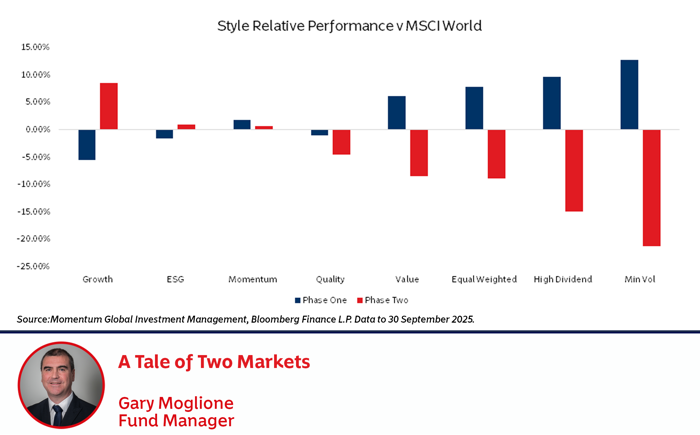
What this chart shows
2025 has been a year of sharp contrasts for global stocks. The chart looks at MSCI World Style indices, showing how different investment styles have performed relative to the MSCI World index. These numbers tell us which styles outperformed or lagged the overall market in each part of the year.
The year splits into two very different chapters:
Phase One: Tariffs and Tech Anxiety (up to 21 April)
The first few months were dominated by uncertainty. The Trump tariff announcements and the “DeepSeek” AI-driven sell-off rattled markets, pushing investors toward safety. Defensive styles shone:
- Minimum volatility outperformed by +12.7%
- High dividend by +9.6%
- Equal weighted by +7.8%Value also did well, beating the market by +6.2%, while Growth lagged at -5.6%. In short, investors wanted stability and income, not risk.
Phase Two: Confidence Returns (22 April – 30 September)
Then the mood flipped. Tariff fears eased, recession worries faded, and risk appetite came back. Growth surged ahead, outperforming by +8.6%, while the previous winners collapsed:
- Minimum volatility underperformed by -21.3%
- High dividend by -15.0%
- Equal weighted by -8.9%
- Even Value, which was strong in ‘Phase One’, fell behind by -8.4%. Momentum barely moved the needle, and Quality slipped into negative territory.
Why this is important
Markets can swing fast. What works in one quarter can fail in the next. That’s why diversification matters, relying on one style or theme can leave you exposed when the tide turns.
This is exactly why we built the Momentum Global Equity Fund. It’s a multi-manager strategy that blends what we believe are best-in-class, high-conviction managers across different styles. While individual styles can be volatile, combining them in a single portfolio helps smooth out the swings and capture both manager alpha and style alpha without taking on unnecessary risk.
As we head into Q4, the big question is: will Growth keep leading, or will defensive strategies make a comeback if volatility rises again? One thing’s for sure 2025 has been a lesson in how quickly market moods can shift.
Global markets faced heightened volatility as US political dysfunction and China trade tensions, UK fiscal uncertainty, EU energy and trade reforms, Middle East ceasefire easing oil risk, and Japan’s political instability combined with rising gold, reflecting broad economic and geopolitical uncertainty.

-
The partial US government shutdown, which began on 1st October, continued to disrupt the release of key economic data (including the September CPI now expected on the 24th), leaving markets without fresh inflation insights.
-
Political standoff highlighted the country’s rising national debt and growing concern about long-term fiscal stability; commentators warned of debt servicing risks.
-
Markets reacted nervously to President Trump’s renewed tariff threats on China (100% tariffs announced), which rattled risk assets and prompted talk of retaliation.
-
Practical policy fallout: the Administration said it would ensure military pay (15th October) despite shutdown, trying to blunt political blowback.

-
Chancellor Rachel Reeves reported to be planning a larger fiscal buffer ahead of the 26th November budget amid weaker growth and higher borrowing costs - taxing/spending trade-offs resurfaced.
-
The Bank of England’s Financial Policy Committee flagged elevated global risks to UK financial stability in its October record.
-
Office for Budget Responsibility/forecasts and think-tank commentary put pressure on Treasury, feeding markets’ concern about possible tax rises and SME squeeze.
-
Market and political attention focused on the November Budget timetable; investors priced in policy uncertainty around fiscal consolidation vs growth support.

-
The EU began a gradual rollout of the Entry/ Exit System (EES) for external borders (biometrics/registration), a major political and administrative development for Schengen travel management.
-
EU ambassadors cleared a political step for a plan to phase out Russian oil and gas imports by 2028, moving energy realignment forward.
-
The EU proposed new steel-sector safeguards, cutting tariff-free quotas 47% and imposing 50% tariffs above limits - a signal of more aggressive trade defence.
-
The EU aims to shore up domestic demand through industrial policy and strengthen its resilience in global supply chains, part of a broader recalibration of trade posture.

-
A temporary Gaza ceasefire and hostage-exchange deal saw Hamas release 20 Israelis and Israel free nearly 2,000 Palestinian detainees, prompting Israeli troop pullbacks and displaced civilians’ return, while easing oil prices as Middle East risk premiums fell.
-
Beijing publicly warned it would retaliate to US tariff threats, calling the moves escalatory and vowing to defend its trade interests, as markets in China and across Asia came under pressure amid renewed trade-war fears and growth concerns.
-
In Japan, Sanae Takaichi’s surprise rise in the LDP leadership race pushed the yen lower and equities higher, but Komeito’s exit from the coalition heightened political uncertainty and cast doubt on her premiership path.
-
Gold surged to record highs on Fed-cut expectations plus political/market uncertainty globally.
